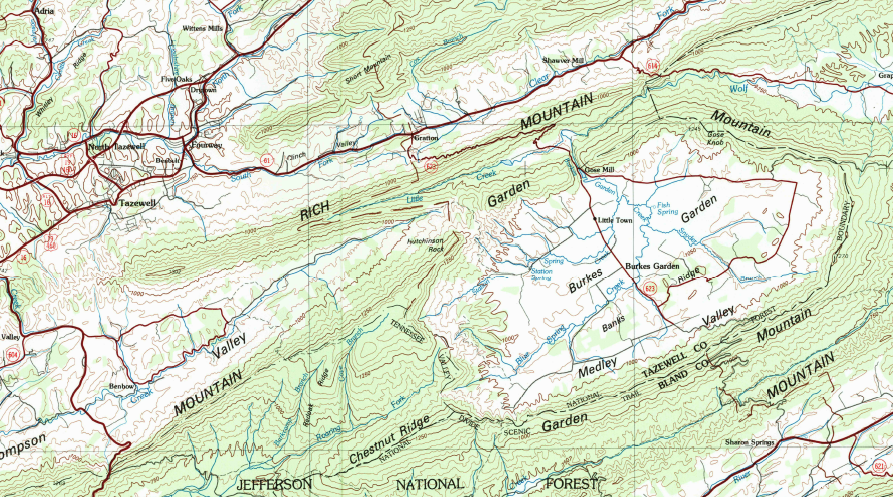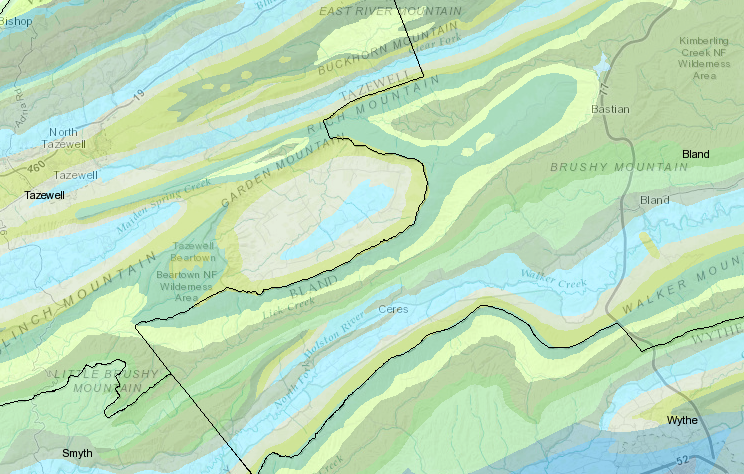
Burke's Garden is a natural valley in Tazewell County, named after James Burk (who never acquired clear title to it)
Map Source: US Geological Survey, Bluefield 30x60 topographic grid (1981)

Burke's Garden is a natural valley in Tazewell County, named after James Burk (who never acquired clear title to it)
Map Source: US Geological Survey, Bluefield 30x60 topographic grid (1981)
One of the most distinctive locations in Tazewell County is Burke's Garden. A combination of erosion and the original tectonic pressures that uplifted sandstone/limestone sedimentary layers created what appears to be a "hole" in the mountains.
One of the earliest recorded explorers to see the unusual valley was James Burk, as he was exploring lands for Col. James Patton to patent. According to family tradition, Burk would go on long hunts with potatoes in his knapsack. He discovered a valley with a clearing, planted potatoes there, and found them growing a year later.
He may have simply discarded a potato that grew by chance, and during a later hunting/surveying expedition found that potatoes were growing 50 miles away from the settlements on the New River Valley. Fresh potatoes were a luxury that far from home.
Burk reportedly blocked an effort by Col. Patton to defraud him of the valley he called "Burk's Choice," and settled there before the start of the French and Indian War in 1755. Burk evacuated his family that year, then in 1756 fled on foot from a Shawnee raid.
Burke was part of the Sandy Creek Expedition led by Col. Andrew Lewis, which marched through the valley he called Burk's Choice on the way to attack the Shawnee in 1756. Today, the valley is known today as "Burke's Garden." That could reflect the comments of the soldiers on that expedition, as they enjoyed potatoes originally planted by Burk.
Despite his discovery, survey, claims, and even recognition through the place name, James Burk was never able to obtain clear title to Burke's Garden. Sometime after 1769, he sold his rights to William Ingles and John Draper.
During the Revolutionary War, James Burk was unwilling to align with the land speculators who had treated him so poorly. He was such a strong loyalist (Tory) that he disinherited a son who sided with the American rebels.1
Thomas Ingles, one of William Ingles' sons, chose to live in Burke's Garden. Thomas Ingles was four years old when he was seized in the 1755 Shawnee raid known as the Drapers Meadow Massacre. When his mother Mary Draper Ingles escaped and took the "long walk home" to Drapers Meadow, Thomas had been adopted into a Shawnee family. His father finally ransomed him in 1768.
By 1782, he was farming in Burke's Garden with his family and slaves when another Shawnee attack disrupted his life. Thomas Ingles escaped and found the Washington County militia already assembled for a muster on the North Fork of the Holston River. The militia tracked the Shawnee party to a camp near the modern Virginia-Kentucky border. In the rescue attempt the Shawnee killed one of his children and wounded his wife with a tomahawk blow to the head. Soon afterwards, Thomas abandoned Burke's Garden and moved to moved to Tennessee and ultimately Mississippi.2
Today, Burke's Garden is the "icebox" of Southwest Virginia. It is often the first place where temperatures drop below freezing in the Fall. On average, the growing season there ends on September 26 as temperatures drop below 32°F. In 2024, however, the thermometer recorded 31°F on September 7.3

Burke's Garden geology
Source: Virginia Department of Mines, Minerals and Energy, Division of Geology and Mineral Resources Online Mapping Tool